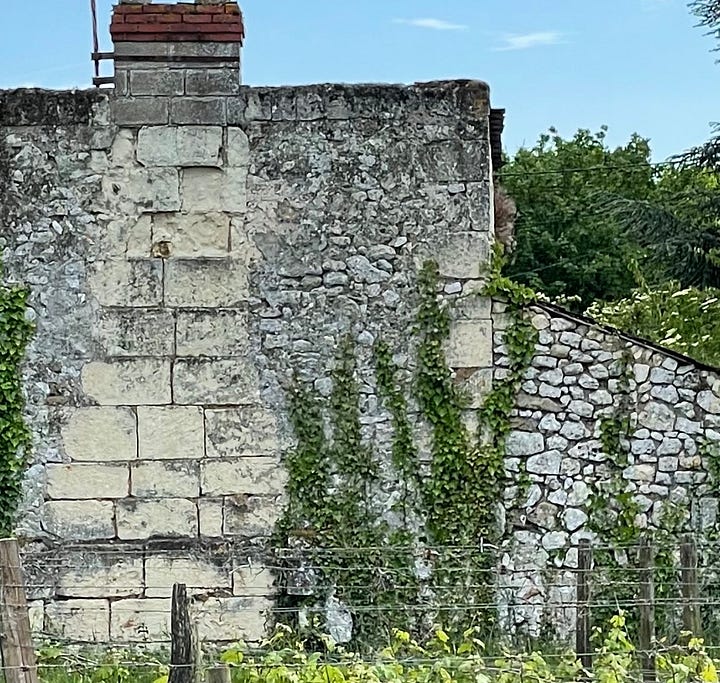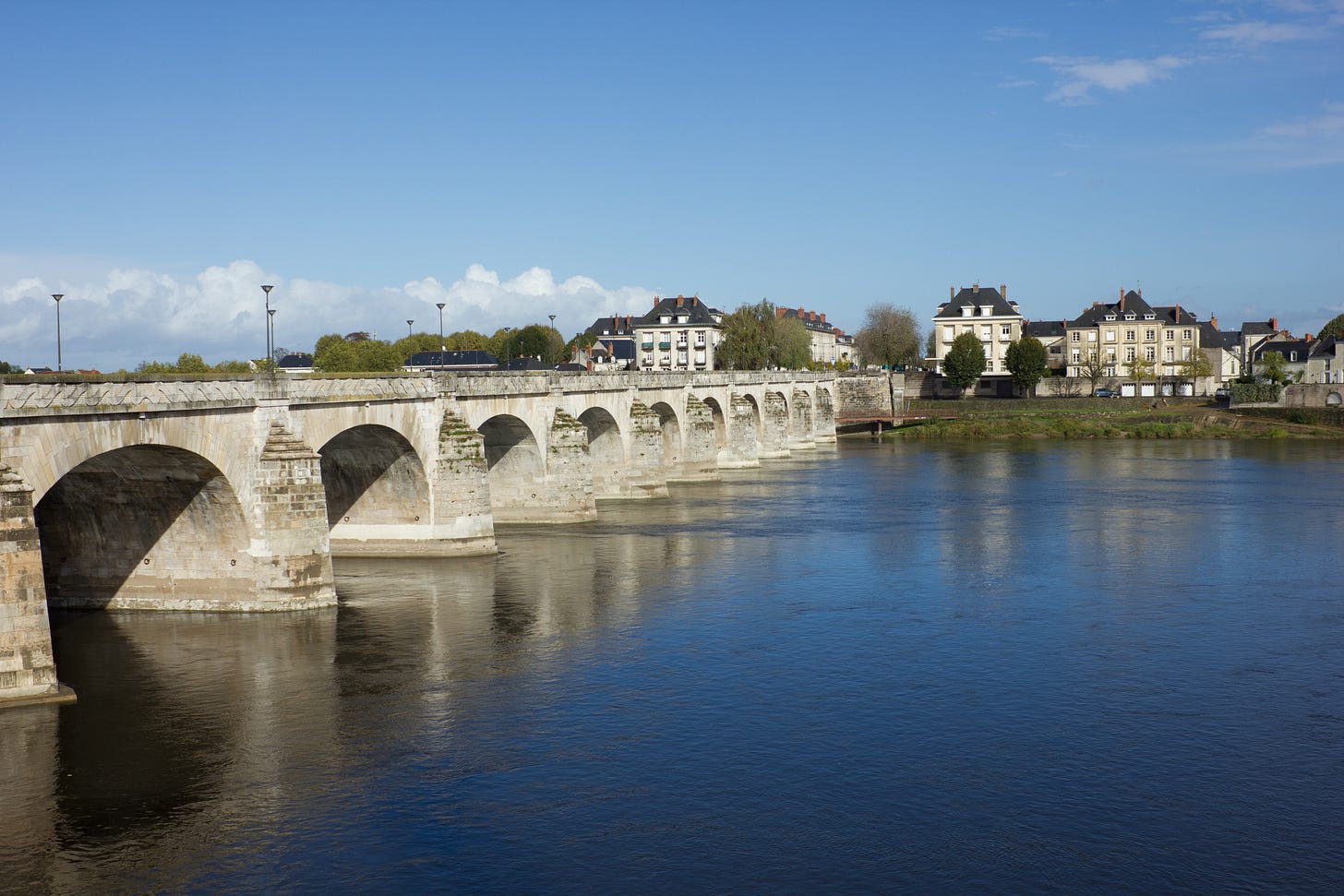A couple weeks ago, I wrote a post highlighting some of the other soils/terroirs of the Paris Basin other than the Turonian tuffeau chalk, which has long been associated with some of the top vineyards and wines across the Central Loire. One of the most unique of these terroirs is the lacustrine (freshwater) limestone that we find in Saumur-Champigny but not in any of the other Cabernet Franc appellations (to my knowledge at least!) in the Central Loire. While there aren’t too many examples of wines that I know of that from this terroir specifically, I wanted to elaborate a bit on this terroir because it is truly a special part of the Saumur-Champigny appellation.
Dating to the Ludian age of the Eocene period (between 37.8 and 33.9 million years ago - denoted as e6b on the geological map below), this lacustrine limestone is found in the highest concentration around the hamlet of Champigny in the commune of Souzay-Champigny, with isolated outcroppings in central Dampierre-sur-Loire and also western Saumur around the hamlet of Saint-Hilaire-Saint-Florent.
Around the hamlet of Champigny, this area where we find the lacustrine limestone stretches across a plateau that is about 2km from north to south. This limestone - known locally as “pierre de Champigny” - is very different from the Turonian tuffeau chalk that is synonymous with Saumur-Champigny. It is very hard and dense, and extremely resistant to erosion, which is why it was quarried many centuries ago for the use of building materials. The beneficial properties of this limestone for building purposes was most notably discovered by engineer Louis-Alexandre de Cessart, who used it to construct the Cessart bridge that stretches across the Loire River in Saumur, which was built between 1756 and 1770.
From a viticultural perspective, centuries before the Cessart bridge was built, it was the monks of the nearby Fontevraud Abbey that identified this area of lacustrine limestone as prime land for the cultivation of grape vines. This hard limestone is less porous than tuffeau chalk, so it doesn’t retain and regulate moisture to the same degree, and it also has very good drainage and low water reserves. As a result, these soils are not very vigorous and are naturally low yielding. In terms of topsoil, across this area and also where the lacustrine limestone pops up in other communes, there is clayey (argile-limoneuse - about 40% clay content) topsoil of moderate depth that helps to balance and regulate moisture. In general, this is a cooler terroir than sites where we find the tuffeau chalk, though budbreak happens here earlier than average, and phenolic maturity happens later than average, so the growing season is quite long allowing for enhanced development of the tannins in the skins and seeds.


In 2022, when I visited some of the vineyards around Champigny with Mathieu Vallée, proprietor of Château Yvonne since 2007, I asked him how this lacustrine limestone differs from tuffeau in terms of the finished wines. He noted that Cabernet Franc on tuffeau can give ample wines, with floury or chalky tannins, and a fleshiness that melds with acidity to give the sensation of volume and breadth in the mouth. In terms of the lacustrine limestone, he suggested that the wines are more direct and angular, with brisk acidity and strict tannins that form a fine, grid-like pattern on the palate.
In the cellar, in recent years, Mathieu has vinified the La Folie with a portion of the bunches left whole cluster (about 15-25%), and the fermentation takes place in concrete with indigenous yeast with about 3 weeks total time on skins, followed by aging for 12 months in large wooden vats. In the glass, the 2022 was a little shy at first and needed about 30 minutes in the decanter to begin to properly express itself. With a bit of time, the wine leads with pure, fresh red fruits like raspberry, cranberry and lingonberry, that mingle with a sweet, succulent herbal undertone of basil. After about an hour, the wine became beautifully floral with notes of jasmine and lilac, with an underpinning of pepperiness (black and pink peppercorns).
While aromatically compelling, the wine’s structure is what excites me, because it does present differently than Cabernet Franc from tuffeau-influenced terroirs. Firstly, I find the acidity presents on the attack at the front of the palate in a way that is invigorating as opposed to refreshing.1 Secondly, the tannin profile is quite direct, finely woven and taut. Moreover, there is a “crispness” to the tannins that is particularly interesting (think: a freshly ironed oxford dress shirt or the feel of percale cotton bed sheets). The tannins are stiff and firm, without being brittle. This combination of acidity and tannins gives a sleekness to the wine, with a structure that is focused, lean and linear, while still having enough plush fruit in the middle palate give a really complete wine from beginning to end. Just for fun, I tasted the 2022 alongside the 2020 to see how the wine evolves with some time in the bottle, and the tannins do indeed relax in a way, but still don’t feel as pliable as the tannins of Cabernet Franc from tuffeau. That’s not to say one is better than the other, just different, and each having their own place on the table. Speaking of table, I think the profile and structure of the 2022 La Folie would lend itself well to a fattier poultry dish, like duck confit or roast goose, or even a slow roasted shoulder of wild boar might work nicely.
As a final thought, I recognize that all of my conclusions and notes are purely subjective, and tasting a greater cross-section of wines from this terroir would be helpful, but I do hope that with time I can provide a guide for those that are interested exploring - in the most nerdy of ways - the diversity of terroirs and expressions of Cabernet Franc across these communes and appellations.
If you think of any beverage that you would describe as “refreshing,” you tend to feel or notice that sensation of refreshment at the end, after you’ve swallowed.








Another fascinating read! So I'm guessing that Fontevrauld Abbey is mainly constructed from freshwater limestone. There must be fossilized shells to be seen in the stone (I never bothered to closely look). And here I thought that it everything around there was constructed from tuffeau. I have one lonely bottle of 2021 Yvonne Saumur-Champigny, but I'll give it some more time. Tonight I'm enjoying some 2022 Philippe Alliet Chinon. Delicious wine. Season's Greetings, Allison.
I had a most pleasant and informative visit with Matthieu in 2019. I walked a long serpentine route there from Saumur. Both a long the river and up on the plateau, stopping often to closely examine the soils and the vines and occasional spontaneous winery visits. My last stop was at Chateau Yvonne. Matthieu fit me into his schedule to taste his wines and inform me in detail about his vineyards. Much of it was in French (there were several French wine friends with us), so I understood about half
of his speaking. When he found out I had been walking all day and was returning to Saumur that evening, he had his wife drive me back to Saumur, which was so nice of them. But that's the type of warm, kind family they are. As I was getting into the car with his wife, he came back out and presented me with a bottle of his 2018 La Folie, which is currently in my cellar. It has been waiting patiently, and I believe the time is drawing nigh. Though I am a mature wines lover and may wait another year or two or three. Over the last few years I have increased my Loire red loving friends, so I'll have good friends to share it with.
Keep up the good work!! And Happy Holidays!!